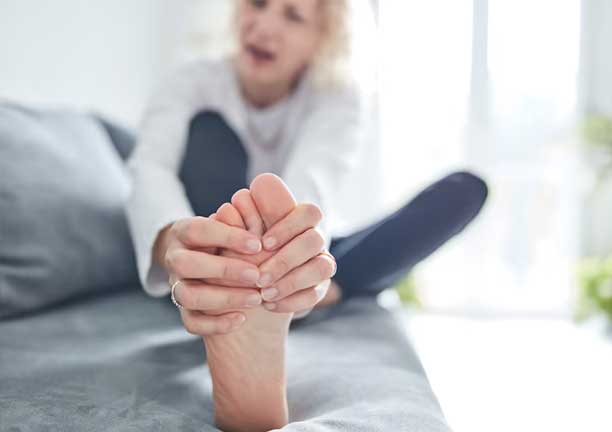Medically reviewed by Dr. Randolph Sealey
Key Takeaways
- Toe pain is often caused by injuries, arthritis, or nerve issues
- Home care may help, but persistent pain should be evaluated
- Certain symptoms indicate it’s time to see a specialist
- OrthoConnecticut provides diagnosis and treatment for all types of toe conditions
If you’re dealing with toe pain that’s interfering with daily life, this guide is for you. Whether you’re a runner, a weekend athlete, or someone simply struggling to walk comfortably, we’ll help you pinpoint the cause and what to do about it.
The toes contain 14 bones, as well as joints, muscles, ligaments, nerves, and blood vessels, all of which can be injured, compressed or infected. The truth is, there are a multitude of reasons why your toes may be hurting, from minor injuries to serious medical conditions.
In this article, we will explore the 6 most common causes of toe pain, including arthritis, hammer toe, and neuroma, and discuss their symptoms and treatment options. We’ll also provide tips for relieving toe pain at home, as well as guidance on when to see a doctor. So, if you’re looking to learn more about the possible causes of your toe pain, read on to discover what you need to know.
6 Most Common Causes of Toe Pain

1. Broken, dislocated or sprained toes
After an injury to the foot, you may notice swelling and bruising, and feel pain in one or more toes. These types of injuries can often resolve on their own with icing, pain relievers, rest and elevation. If pain and swelling persist after three days, consult a physician, particularly if the injury is in the big toe.
2. Arthritis (including Gout and Hallux Rigidus)
Toe Osteoarthritis
Caused by wear and tear of the cartilage in the joint, most often in the big toe, arthritis can cause pain, aching, and possibly burning. It can also lead to pain in the arch and the other toes.
This can be treated with pain relievers and ice, as well as a change in footwear. Medical treatment can include custom orthotics and steroid injections. In the case that bone spurs are formed, then surgery may be necessary. Tips to help with Osteoarthritis →
Rheumatoid Arthritis of Toe
Rheumatoid Arthritis (RA) of the toe is a chronic autoimmune disease that affects the joints, causing inflammation, swelling, and pain. The condition occurs when the immune system mistakenly attacks the synovium, a tissue that lines the joints, leading to the breakdown of cartilage and bone.
Symptoms of RA in the toe may include:
- stiffness
- tenderness
- warmth
- redness
- difficulty walking or performing daily activities
The causes of RA are not fully understood, but genetics, hormones, and environmental factors may play a role. Early diagnosis and treatment of RA are important to prevent joint damage and deformity. Treatment may include medication, physical therapy, and surgery.
Gout
Gout is a form of inflammatory arthritis that is the result of crystals of uric acid accumulating in the joint, causing severe, sharp pain, as well as redness, swelling and/or stiffness in the joint. Gout most commonly forms in the joint of the big toe.
Gout attacks are treated with NSAIDs (non-steroidal anti-inflammatory drugs). In cases of chronic gout, lifestyle changes such as weight loss and reduced alcohol intake are necessary, along with prescription medication.
Hallux Rigidus
Hallux Rigidus, which translates to mean stiff big toe, is a form of degenerative arthritis progressive that causes restriction in the big toe joint, eventually causing it to no longer bend. It causes stiffness, pain, swelling, causing walking and other activities to be difficult.
Treatment can include custom orthotics, steroid injections, physical therapy. In some cases, surgery is necessary.
3. Hammer Toe
A hammer toe usually affects the second, third or fourth toe. This condition causes the toe’s middle joint to get stuck in a bent position (so it looks like a hammer). Over time, the joint becomes immobile, and the muscles and tendons in the toe become shorter.
It is usually caused by wearing tight shoes that compress the toes, so a change to roomier and flat shoes is always the first line of treatment. Splinting can also help, as well as targeted exercises. If the joint becomes immobile, surgery may be necessary.
4. Neuroma
Nerve tissue growth that causes pain between your toes when walking. The most common foot neuroma is called Morton’s Neuroma (or intermetatarsal neuroma), when the tissue surrounding the nerve between the third and fourth toes becomes inflamed and thickens.
Treatment usually includes icing, footwear modification, NSAIDs, steroid injection, and custom orthotics to relieve pressure on the area. Surgery may be necessary in severe cases to remove the growth.
Meet Marianne.
Marianne is a 58-year-old who walks 3 miles every morning. A few months ago, she started feeling a burning, tingling sensation between her third and fourth toes.
At first, she thought it was just a blister or tight shoes. But the pain got worse, especially when she walked barefoot on hard floors. Eventually, she was diagnosed with a Morton’s neuroma and began treatment that included orthotics and physical therapy.
Her story is common — and a great reminder that even minor toe pain can point to something deeper.
5. Tendinitis
Inflammation of the tendon, which connects fiber to bone. This can happen in any joint, including the toes. Treatment most often involves NSAIDs, resting, physical therapy, and possibly a steroid injection. Rarely is surgical intervention necessary.
6. Plantar Plate Tear
A plantar plate tear is caused by a rupture of the connective tissue or ligament along the ball of the foot that connects to the toes. It can cause pain along the sole of the foot that reaches up to the toes, most often the second toe.
This is usually caused by a trauma or injury, but can also result from degeneration. Treatment involves NSAIDs, a change in footwear, custom orthotics and sometimes a toe splint. In severe cases, surgery is necessary to repair the plate.
Symptoms That Can Occur with Toe Pain
Toe pain symptoms include:
- swelling
- bruising
- burning
- tingling
- discomfort when walking
- changes in the toe’s appearance
Relieving Toe Pain
The best approach to treating toe pain at home is to rest your foot. While it can be difficult to stay off your feet, resting the affected foot will provide relief. Taking an NSAID will also relieve pain, along with icing the affected area. If you must walk around when experiencing toe pain, wear comfortable, padded, flat shoes.
When to See a Doctor About Toe Pain
If your toe pain persists for several days, it is best to see a physician. Your physician will determine the cause of your toe pain to properly treat you. If your primary care physician determines that your toe pain is the result of a structural issue or injury, he/she will then refer you to an orthopedist for treatment.
OrthoConnecticut Can Help
OrthoConnecticut’s highly-trained, board certified physicians can evaluate your condition and determine the best line of treatment for your toe pain, based on your toe condition.
We always take a conservative approach, preferring non-surgical treatment as the first approach. OrthoConnecticut can provide custom orthotics if necessary, and provide on-site physical therapy to treat certain toe conditions.
In situations when toe surgery is necessary, OrthoConnecticut’s team of experts can provide the safest, most professional and caring surgical treatment.
Conclusion
Toe pain can be a debilitating condition that can affect your daily life. There are many potential causes of toe pain, including trauma, arthritis, and nerve damage. However, with the help of your healthcare provider, you can identify the root cause of your toe pain and determine the best treatment plan for your needs.
If you are experiencing toe pain, it’s important to seek medical attention to ensure proper diagnosis and treatment. In addition to any medical interventions, there are some lifestyle changes you can make to help alleviate toe pain, such as wearing proper footwear and practicing good foot hygiene.
Remember, taking care of your feet is an important part of overall health and wellness. Don’t hesitate to reach out to your healthcare provider if you are experiencing any foot pain or discomfort. By taking proactive steps to address your toe pain, you can improve your quality of life and get back to doing the things you love.
FAQs
Toe pain is serious if it lasts more than a few days, worsens over time, involves significant swelling or bruising, or makes it hard to walk. If you can’t move the toe or the pain is sharp and sudden, see a doctor.
Common causes include arthritis (like gout or hallux rigidus), a sprain, or overuse. Joint stiffness, swelling, or a grinding sensation often point to arthritis.
A sprained toe involves stretched or torn ligaments, while a broken toe involves a fracture in the bone. Sprains cause swelling and bruising but usually allow some movement; a break often causes intense pain, deformity, or inability to move the toe.
Yes. Arthritis, especially gout or hallux rigidus, often affects a single toe (most commonly the big toe) and causes pain, swelling, and stiffness in that joint.
Rest the foot, ice the area, elevate it, and take over-the-counter anti-inflammatories. Wear supportive, padded footwear and avoid pressure on the painful toe. If pain persists, see a doctor.
Still unsure what’s causing your toe pain? Book a diagnostic evaluation with one of our foot and ankle specialists today.



















